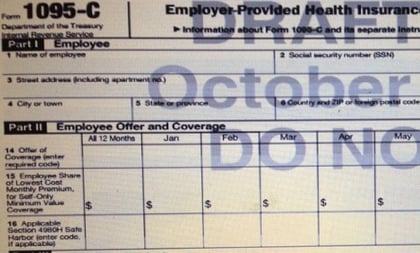Agents and brokers have had their challenges when it comes to the Affordable Care Act and Internal Revenue Code Section 6056 reporting.
It was difficult for a broker to take the stand back and watch approach as clients were increasingly leaning on their brokers to guide them with everything that is ACA.
Situations involving Internal Revenue Service Letter 226J and forms 14764 and 14765 are where employers are going to be looking to their broker for help and guidance now.
When employers open that dreaded IRS envelope, and the first thing they see is a big penalty in bold, they are going to reach out to their brokers. Brokers need to be knowledgeable.
(Related: Employers Face ACA Social Security Number Reporting Snarl)
Just because an employer hasn’t received a letter yet doesn’t mean the employer is in the all clear.
So, brokers, dust off your 2015 ACA rules and be ready for the phone call from your client.
Pre-Letter File Reviews
Brokers should be proactive and review each client’s 1094-C, even if they didn’t do the client’s filing.
Brokers should try to see for themselves if the client could receive a penalty letter, and provide their clients with a list of the options available.
Brokers should confirm their affordability calculators per client, confirm that minimum essential coverage was offered to at least 70% of the full-time employees, and check for the correct coding on the 1095-C’s. Example: Were boxes 1A and 1E filled out properly?
Clients are going to look to their brokers to help with their response to their 226J letter, but, more importantly, with the Form 14765 Premium Tax Credit.
Brokers should know how their clients handle qualifying events and status changes which could lead to “B” penalties.
If an employee went from full-time to per diem:
- Was the offer made through the stability period?
- Was the employee tracked for 3 months and coverage termed the first of the fourth month (if fewer than 130 hours, on average, per month) and COBRA offered?
Each employee on the 14765 needs to be fully reviewed, coding corrected and “B” penalty paid, as applicable.
This can be a cumbersome task, so brokers need to be ready to provide their clients with relief. It will be time to step up to the plate show your clients you are more than just a renewal broker but a subject matter expert!
Brokers should stay on top of guidance and also familiarize themselves with the Treasury Inspector General’s Employer Shared Responsibility Provision (ESRP) audit results that were issued in March 2018. The audit revealed that the IRS did not identify 840 employers potentially subject to more than $113 million in ESRP responsibility. The failure to identify these employers as applicable large employers (ALEs) occurred because the information used by the IRS was incomplete or inaccurate.









 July 09, 2018 at 05:25 PM
July 09, 2018 at 05:25 PM











 Lisa Allen is vice president of regulatory affairs at
Lisa Allen is vice president of regulatory affairs at